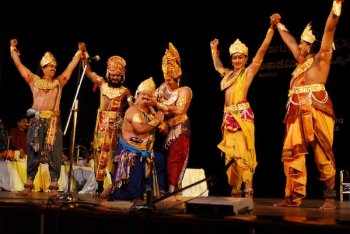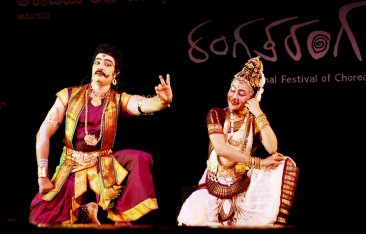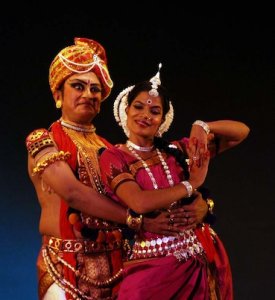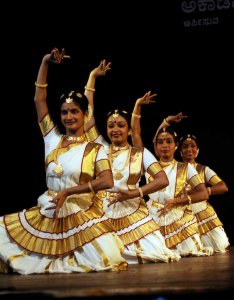
|   |

|   |
Rang Tarang National Festival of Choreography - Bhagya Lakshmi, Bangalore May 24, 2012 Bangalore hosted the National Festival of Choreography titled Rang Tarang, a three day event (April 25-27) which was the brainchild of Vyjayanthi Kashi, Chairperson, Karnataka Sangeet Nritya Academy. It was jointly organized with Academy of Music. This was a sincere attempt to bridge the various dance styles of India with their uniqueness and topicalities. The festival was inaugurated by acclaimed musician Rama Mani, followed by the signature song of Rang Tarang well sung by Ramya Suraj. The morning workshop session of the first day saw the doyen of Kathak, Guru Dr. Maya Rao with the Natya team zealously rendering the nuances of their Kathak gharana, interspersed with skillful demonstrations to be emulated by a group of young students who had enrolled for the workshop. There was ample scope to introduce the students to Kathak and ‘Maya didi’ as she is popularly known, did full justice to it, belying her ripe age, as usual. Guru Aruna Mohanty spoke passionately about the Odissi form. Her ensemble gently and dynamically supported with movements. The singular features of Odissi like tribangas, chaukas, the peacock movements and the feel of the raindrops were demonstrated and delightfully tried by the participants.
The second day began with the workshop of P Ramalinga Shastry from Hyderabad. He gave useful insights into the distinct comparisons and contrasts between Bharatanatyam and Kuchipudi so often blurred by practitioners. This was followed by Mohiniattam headed by Guru Shyamala Surendran from Kerala. She spoke about the softer adavus like the Bharatanatyam DiDiTai-s. She also stressed on the importance of a spiritual journey that one should feel and enjoy even while beginning basic steps of Mohiniattam.
The last day of the workshop had Manipuri, not very familiar to southern audiences. The Raasleela and martial dances were immensely appealing and Priti Patel kept the audience spellbound, with the beautiful lasya and tandava aspects. The involvement of these artistes, despite tough situations, especially in the northeast of our nation is commendable. Stalwart Guru Revati Narasimhan explained her approach to abhinaya in Bharatanatyam. The padam “Ententu Vacchitiveera” often performed by dancers was treated in the traditional subtle style and so were the pallavi of two varnams. The typical sambodhana gestures in varnams drew our attention to how the abhinaya in varnam has to be definitive with some natyadharmi expressions as well. She chose to teach some stanzas from the javali “Parulanna maata” to the aspirants and here the lokadharmi style was effectively employed. The curtain of the choreography festival in the evening session rose with the presentation of a colorful dance presentation billed as ‘Sare jahan se achcha.’ This production choreographed by Dr. Maya Rao was performed by her team of senior dancers Madhu Nataraj, Tushar Bhat, Janardhan Raj Urs, Ponnamma, Ramya and others, who kept the audience spellbound with their synchronized movements. The choreography was rich in purity of tradition. Every line of the song was aesthetically visualized through dance theatre and multimedia production. Aruna Mohanty and her team members of the Orissa Dance Academy started with ‘Jagannantha Ashtakam’ followed by a Khamaj Pallavi in Taal Ekatali with graceful movements, intricate formations, lines criss-crossing each other accompanied with a richly recorded music. The dancers created an impact with their peerless presentation of ‘Navarasa.’ The evening ended with “Paada sevipare paavana” rendered by DS Srivatsa choreographed by Rekha Hegde, a well trained Bharatanatyam dancer from Belgaum. Her conceptualization of Dasavatara was neat and her students performed the jatis set to different visual patterns that blended well with the theme. The only production that made good use of live music was the Yakshagana ‘Sashirekha Parinayam’ performed by Pasumarthy Ramalinga Sastry and his 30 member group from Hyderabad. The main characters handled their respective roles with elegance. Throughout the entire production, one could feel the richness of the Kuchipudi Yakshagana in angika, vachika aharya and satvika aspects. The live music added to the dramatic element of Kuchipudi. D.V.S Shastry’s correct diction with his melodious and bhava filled singing especially during the abhinaya sequences deserves special mention.  Yakshagana  Mohini Basmasura  Probal Gupta & Madhulita Mahapatra  Mohiniattam Shyamala Surendran and her group began with group choreography on Lord Ganesha with Chollikettu followed by a Thillana. The choreography was handled with restraint. The team concluded their presentation with ‘Thatwamasi,’ unfolding the story of Lord Ayyapa in a soulful and sublime rendition. Probal Gupta’s choreography of Rabindranath Tagore’s dance drama ‘Shyama’ using Karnataka Yakshagana (Thenkuthettu), Kathakali and Odissi to portray different characters was apt and beautiful. All the artistes justified their styles and roles. Probal made good use of multimedia to introduce the various characters along with backdrops concurrent to the scenes. The festival on the third day featured three performances by Venkateshwara Natya Mandira, Attakkalari Centre for Movement Arts and Anjika dance ensemble from Kolkata. However, the piece de resistance of the evening was ‘Malem’ presented by Priti Patel and her team dominated by male artistes. It was a visual treat and showed the immense possibilities that the dance form has to keep the audience riveted to their seats. ‘Malem’ is about the eternal womb from where all life has taken birth. She is the mother and sky or heaven, Dyaus, is the father. The point where the earth meets the sky is the horizon Kshitish, which is endless and through this meeting of two primary elements of the universe, universal harmony is achieved. Priti achieved this through her choreography by bringing a balance of the tandava and lasya elements of Manipuri accompanied with live and recorded music. Vocal support through the taped music blended well and added a special effect to the chanting of the mantras. Venkateshwara Natya Mandira presented ‘Mohini Bhasmasura’ in the Bharatanatyam style choreographed by senior Guru Radha Sridhar. Though one was disappointed with the low quality music, Sanjay Shantaram as Bhasmasura and Aishwarya Nityananda as Mohini charmed the audience with their abhinaya and nritta. One felt that editing this production at certain places could make the production more effective. The finale to the festival was by artistes of Attakkalari Centre for Movement Arts. The dancers presented short pieces making use of props and changes in costumes and colors. Swift transition between pieces helped to maintain the tempo. One experienced a harmonious blend of music, movement and language in their dance pieces, which were other than the usual. The last piece was aptly chosen by the dancers inviting the audience to join them; a coming together of many hands clapping to the rhythm of many dancing feet - a joyful ending to the festival. Kudos to Kashi for this well organized festival that enthralled the audience with wonderful dances performances, educative workshops, learning sessions that lay the foundation for a recurring annual treat. |